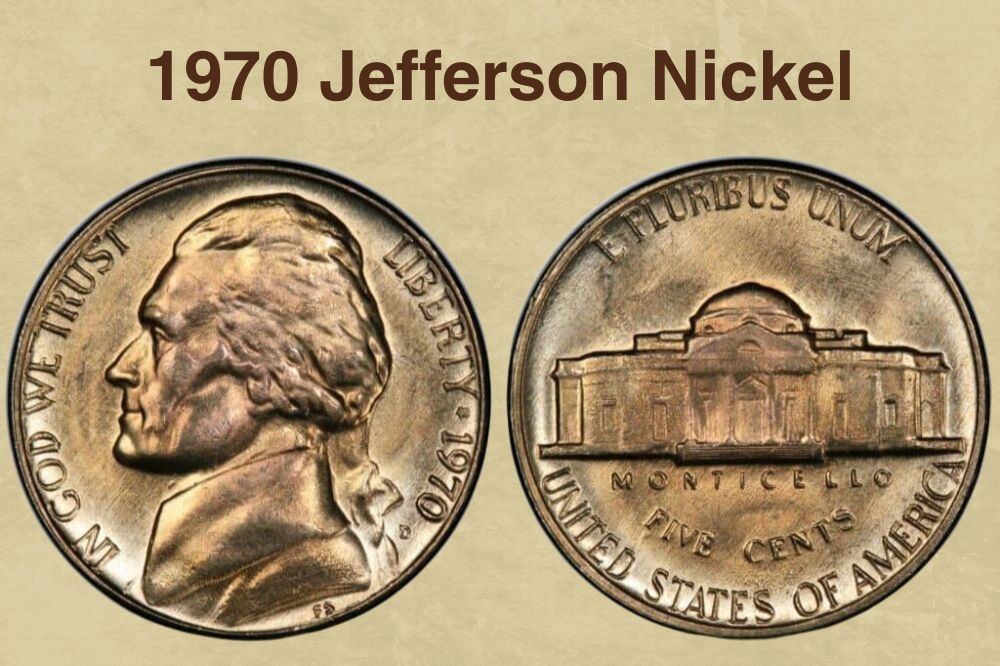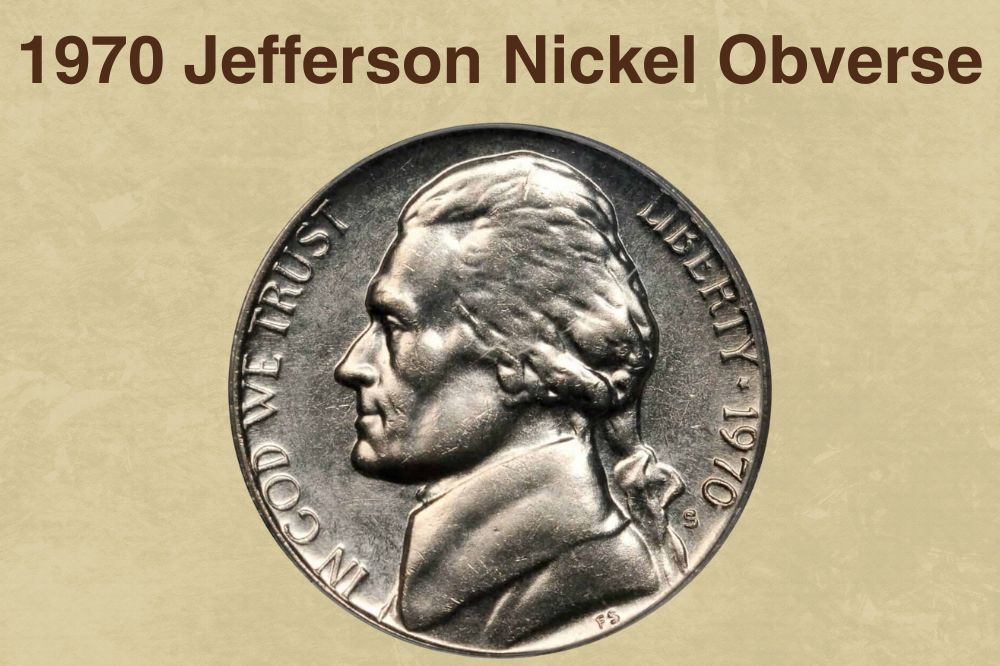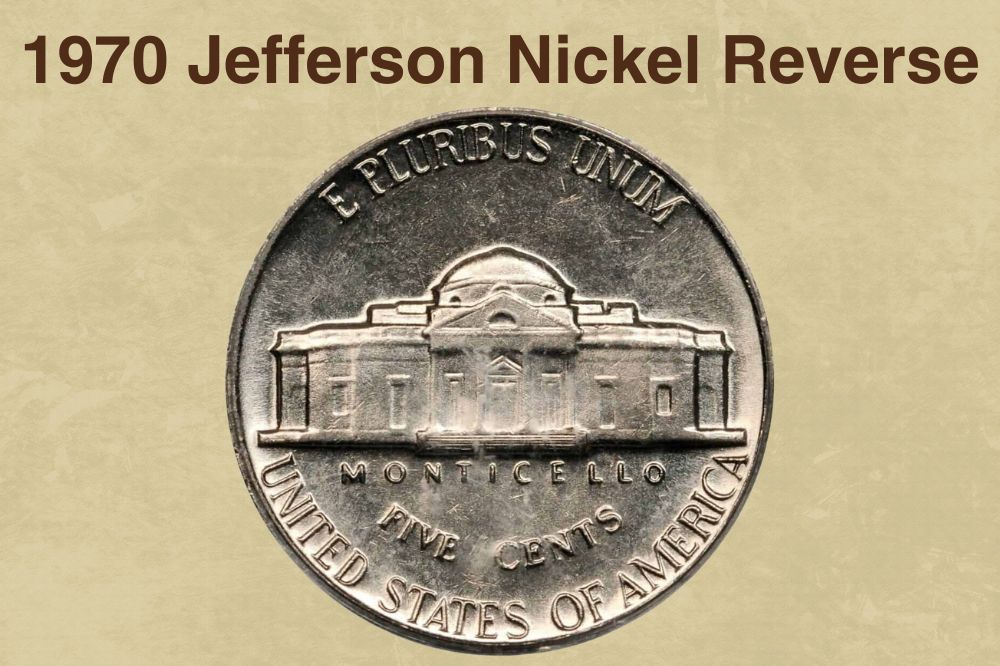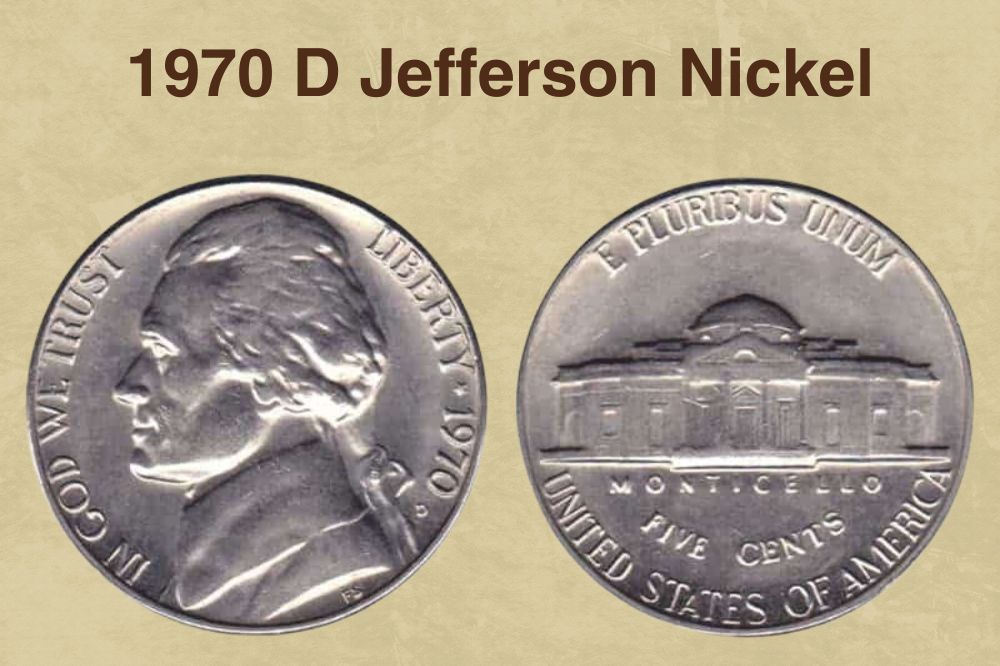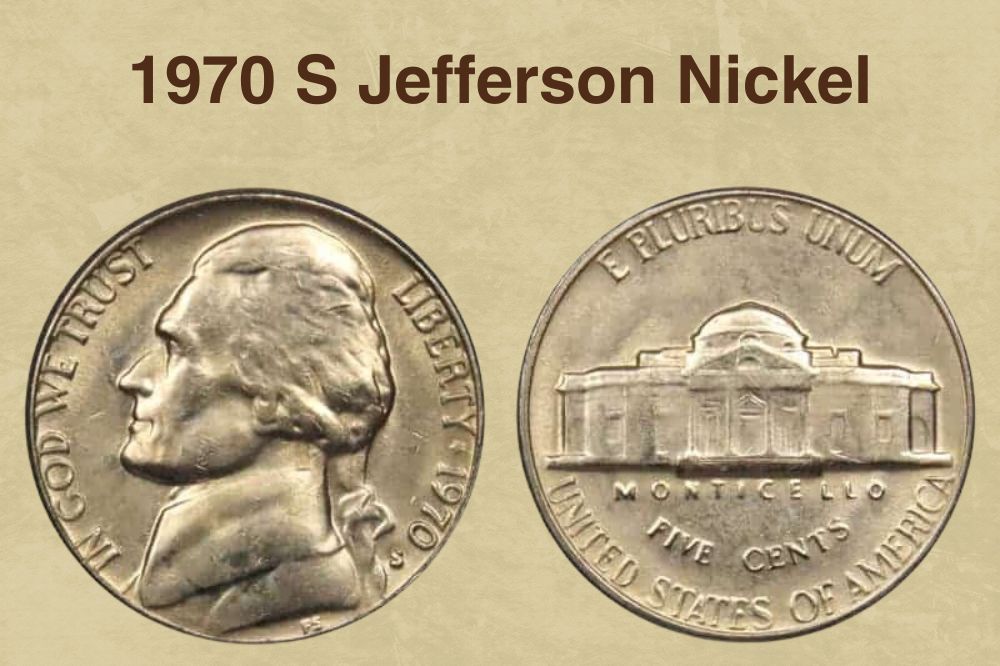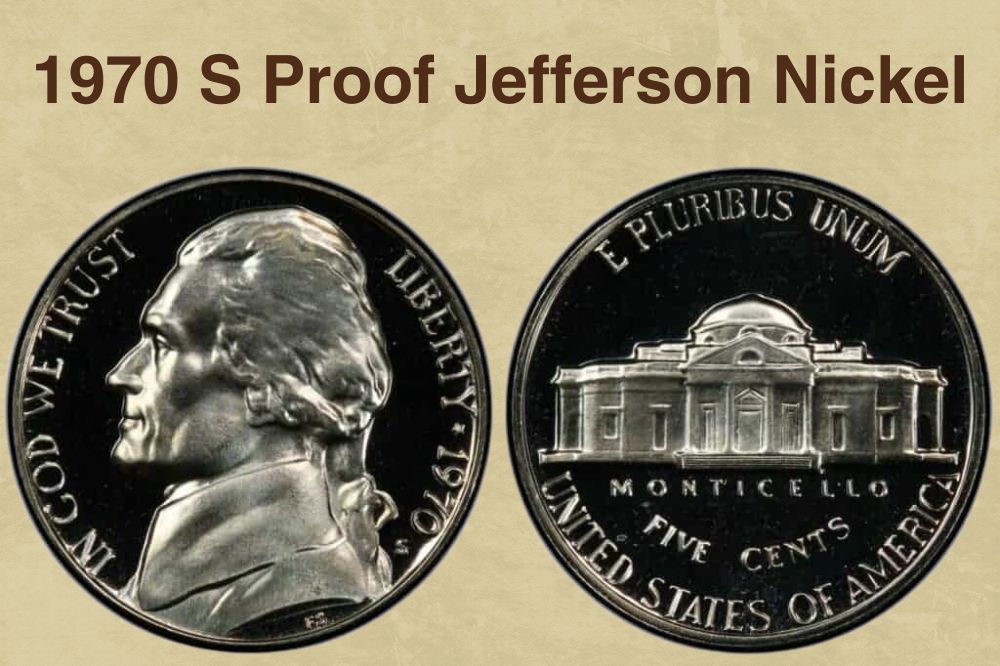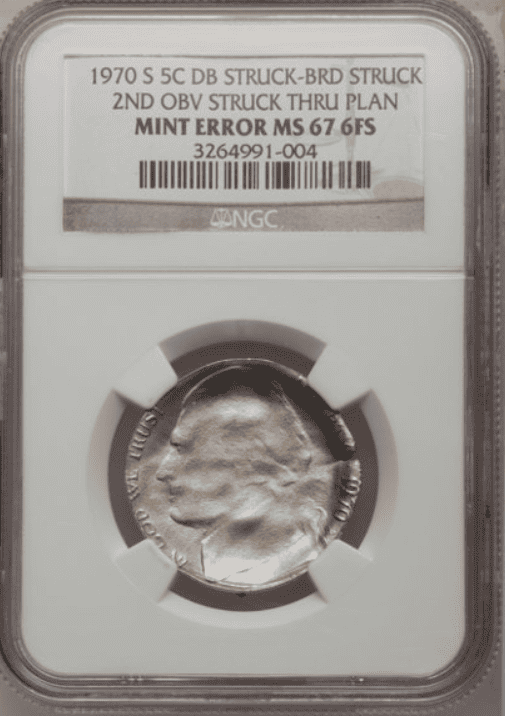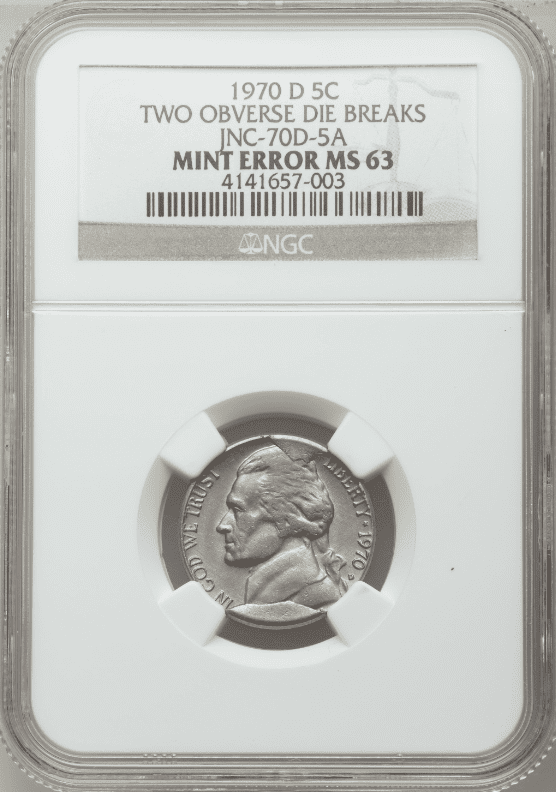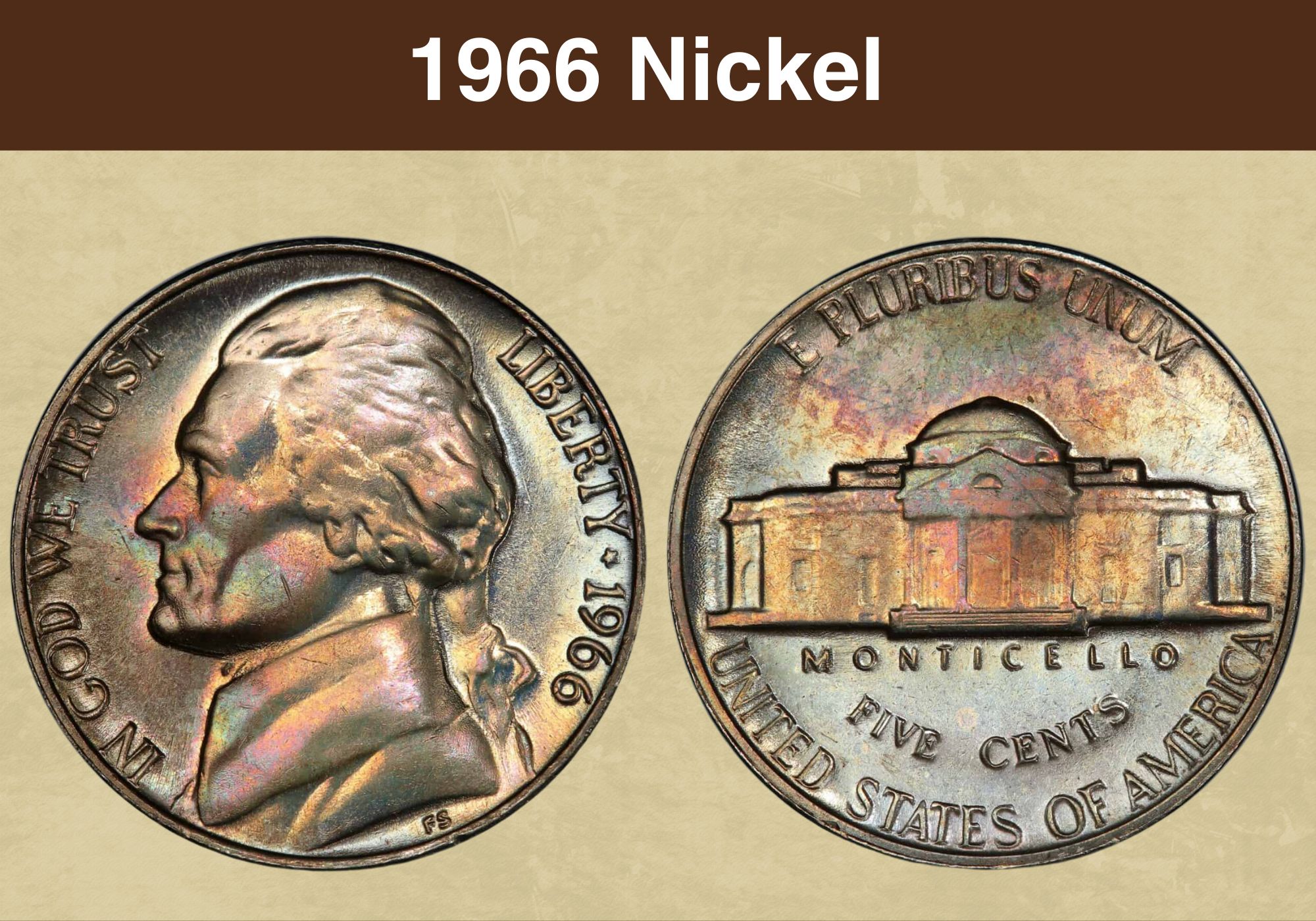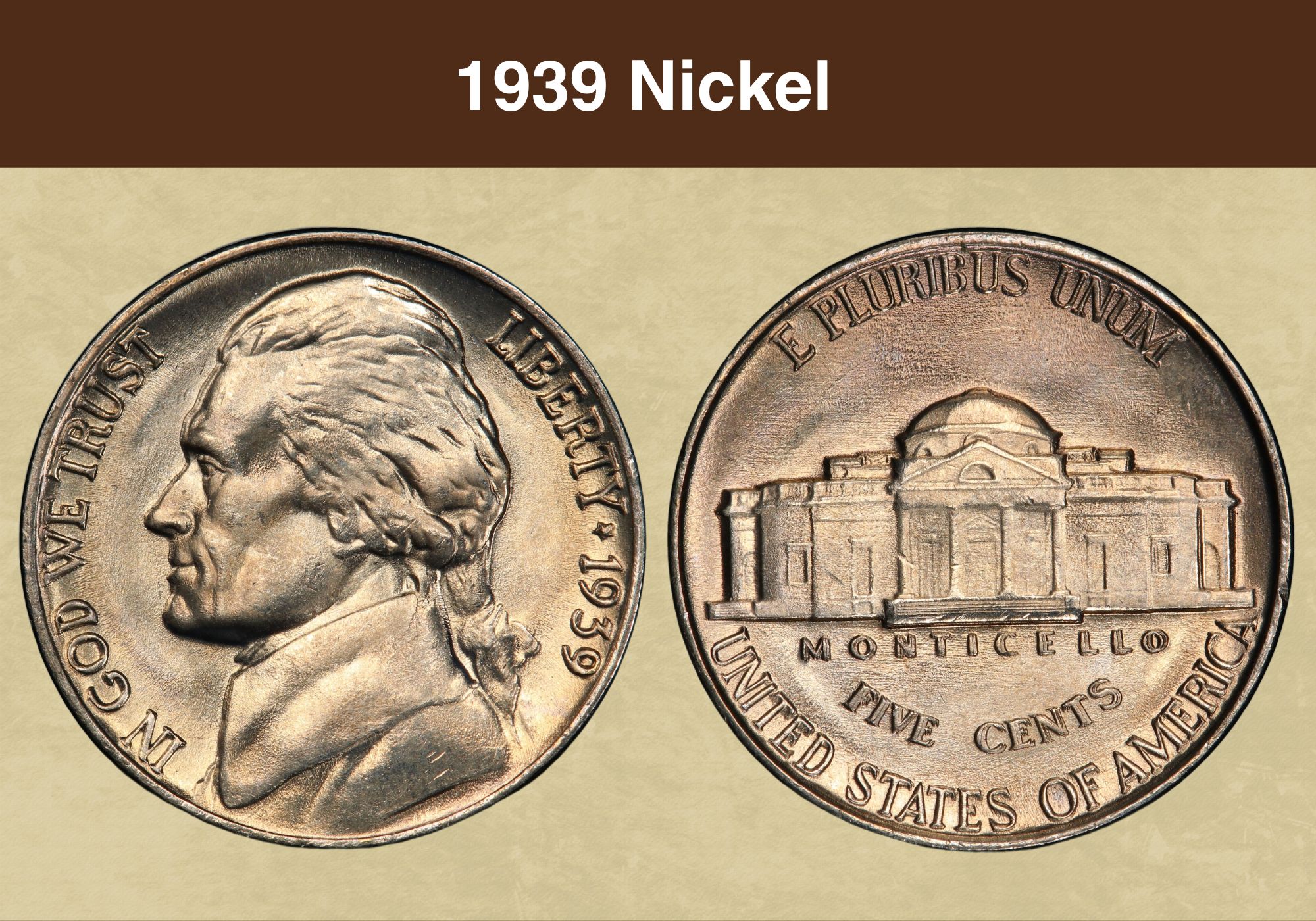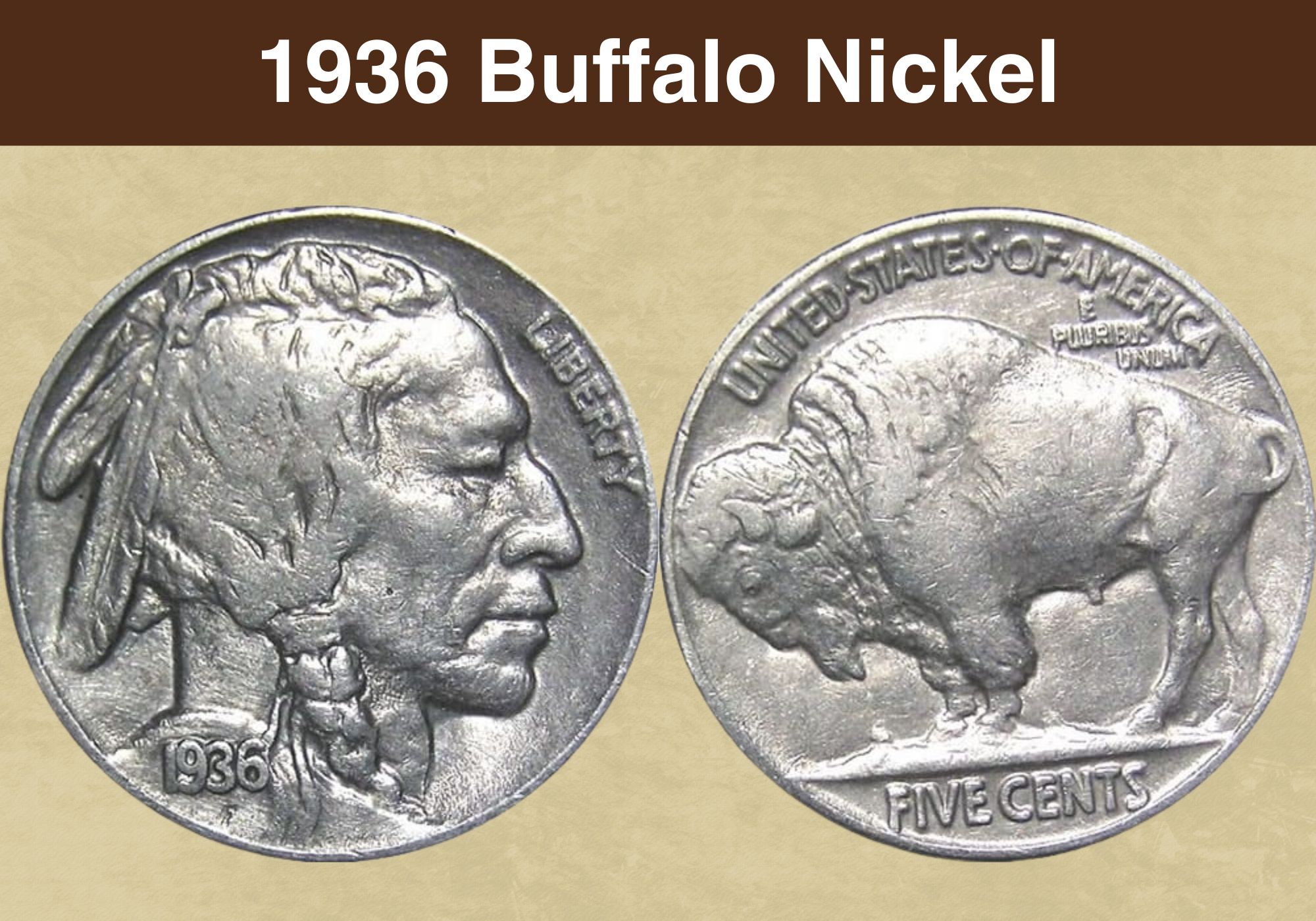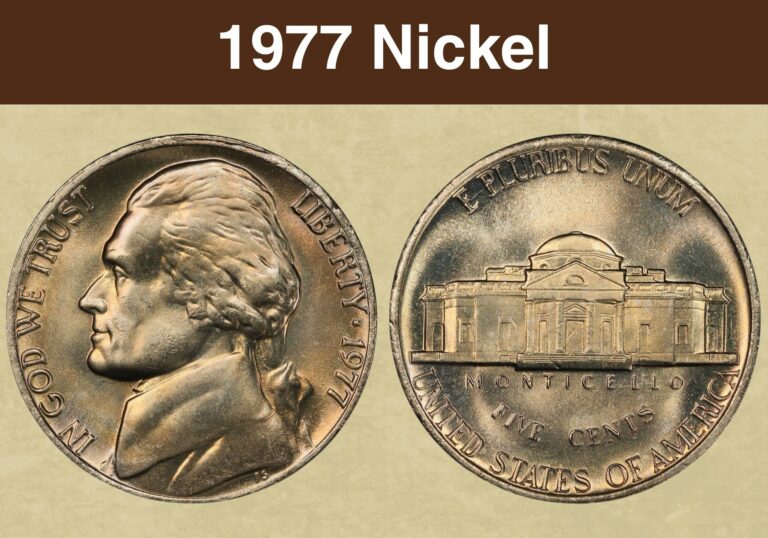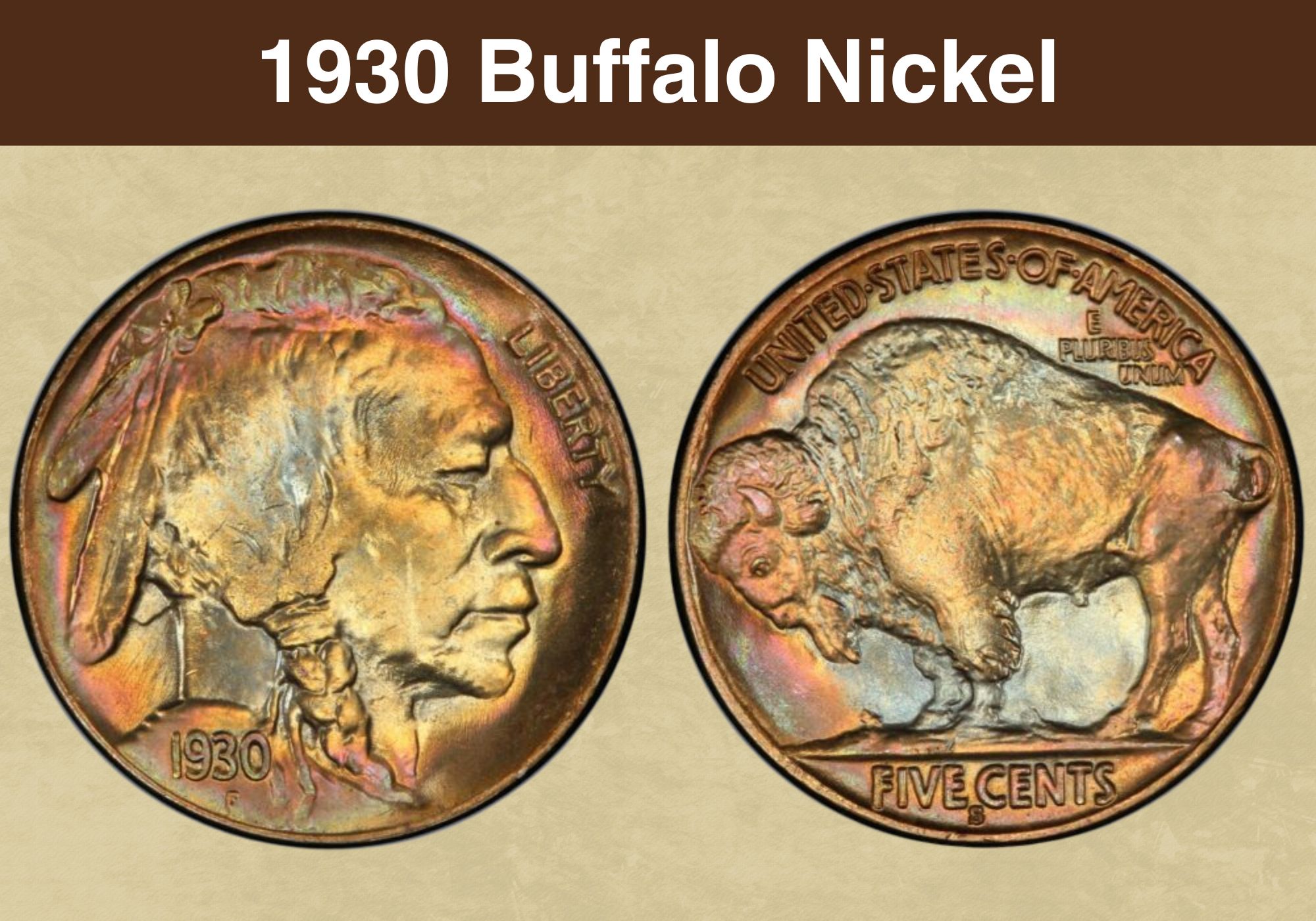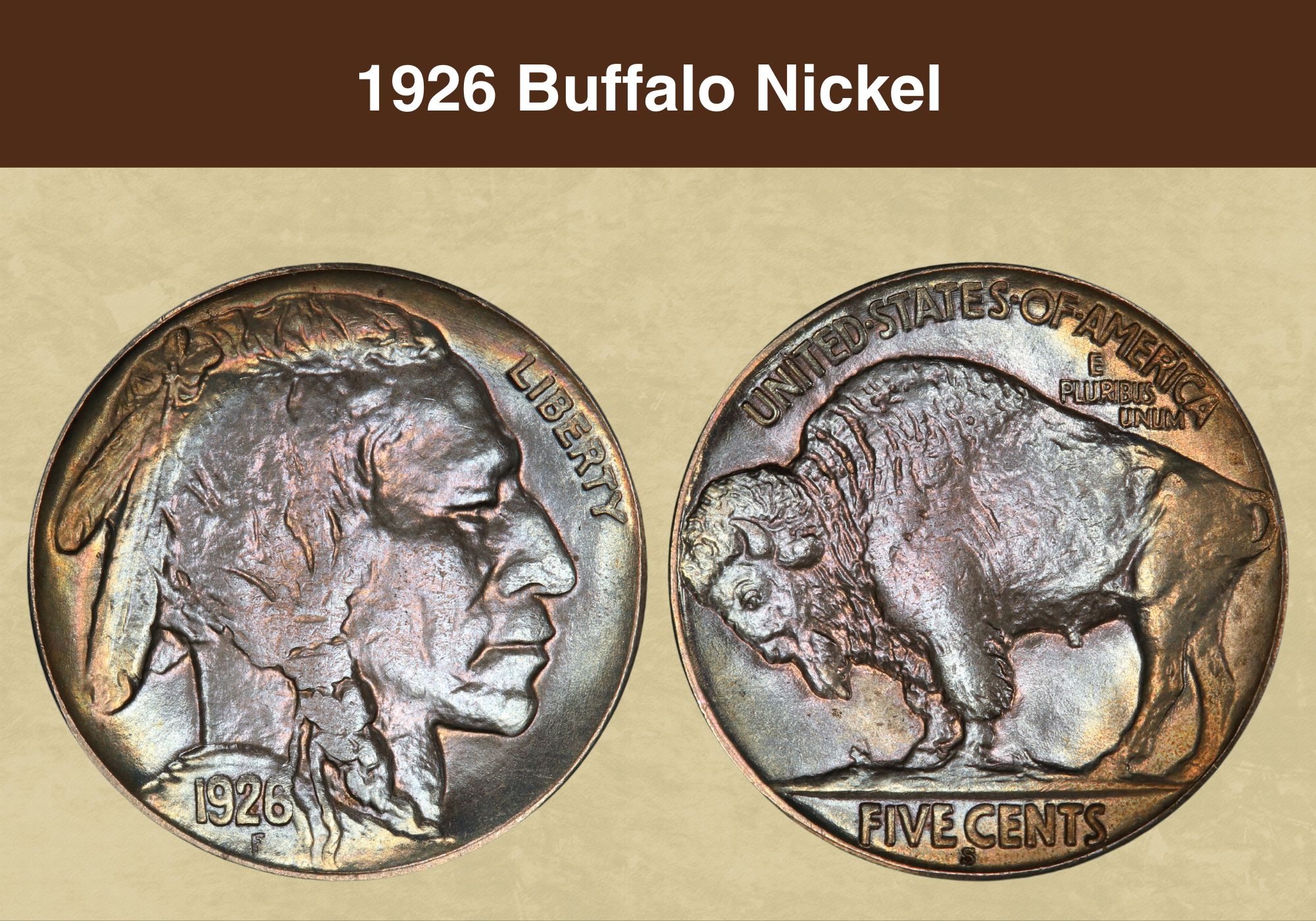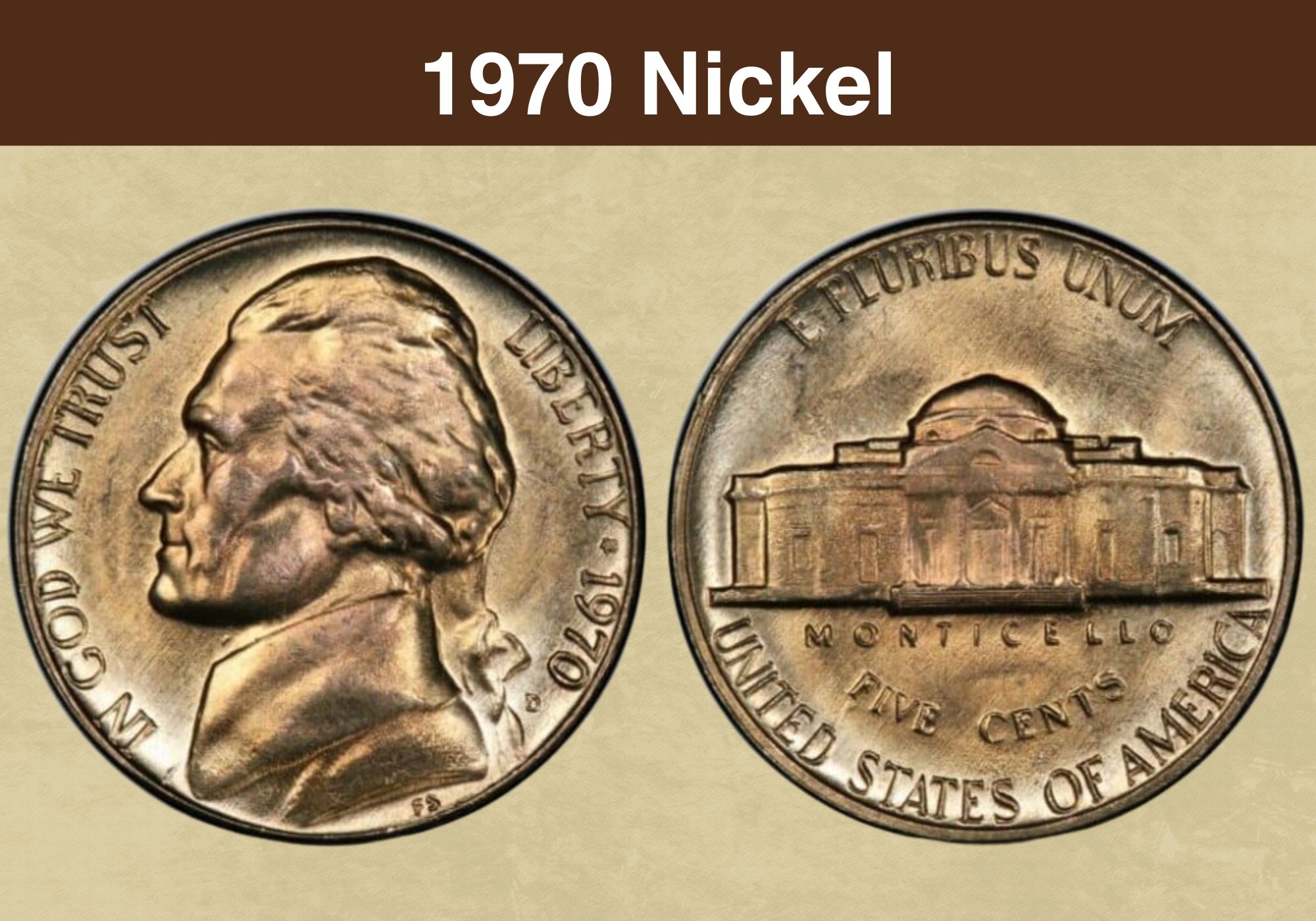
Coin Value Contents Table
If you have a 5-cent coin from 1970, it’s what’s known as a Jefferson nickel. And some of those coins are worth much more than others.
So what makes the difference – and why?
That’s what we’re here to investigate. We’re going to dig deep into the 1970 nickel value. We’ll learn how much it varies, and the factors that cause that variation. And we’ll look at the history and design of this interesting coin along the way.
Ready to learn more? Then let’s get started!
1970 Nickel Value Chart |
||||
| Mint Mark | XF45 | MS60 | MS65 | MS66 |
| 1970 D Nickel Value | $0.05 | $1 | $26
Full steps: $5,500 |
$70
Full steps: $10,500 |
| 1970 S Nickel Value | $0.05 | $1
Full steps: $32 |
$24
Full steps: $500 |
$60
Full steps: $3,500 |
| PR60 | PR65 | PR67 | PR69 | |
| 1970 S Proof Nickel Value | $1
Cameo: $1 Deep cameo: $3 |
$1
Cameo: $4 Deep cameo: $5 |
$3
Cameo: $8 Deep cameo: $17 |
$10
Cameo: $18 Deep cameo: $400 |
History of the 1970 Nickel
The nickels struck in 1970 are part of the series known as Jefferson nickels. The name comes from the portrait of the US president, Thomas Jefferson, which appears on the obverse.
The first Jefferson nickels had been issued over thirty years previously. They had replaced the distinctive Buffalo nickel, which had proven difficult to strike cleanly.
Despite 5-cent pieces generally being called nickels, their metal content varied over time. The 1938 versions had the same composition as modern coins – 75 per cent copper and 25 per cent nickel.
But the Second World War increased the demand for nickel for use in the manufacture of munitions. And from 1942 to 1945, the alloy used for the coins included lower quantities of copper mixed with silver and manganese.
At first, Jefferson nickels were produced by the Mint facilities at Philadelphia, San Francisco, and Denver. But in 1970, the Philadelphia Mint was otherwise engaged, and you’ll only find nickels from that year with the “D” and “S” mint marks.
In 1971, the San Francisco facility stopped producing nickels for everyday use. It continued to strike proof coins for collectors, however.
The design of the Jefferson nickel has changed several times over the years. The coins issued in 1970 have the original design by Felix Schlag. Schlag’s design for the reverse still appears on modern nickels, although the obverse is now designed by the artist Jamie Franki.
Also read: Top 10 Most Valuable Nickels Worth Money
Features of the 1970 Nickel
The Obverse of the 1970 Nickel
The obverse, or “heads” side of the 1970 nickel has a portrait of President Thomas Jefferson by a German artist called Felix Schlag. Jefferson is depicted in profile, facing to the left as the coin is viewed. And he appears to be smiling slightly.
The same design was used until 2004, when special edition coins were issued to commemorate the Lewis and Clarke Expedition. The obverse was changed again in 2006, using a new portrait by the American artist Jamie Franki.
His source material was probably a bust of the former president by the renowned French sculptor, Jean-Antoine Houdon. It wasn’t the first time a sculpture by Houdon had been used in the design of a US coin. His bust of George Washington had also been the basis for the portrait on the quarter.
The nickel has the motto “IN GOD WE TRUST” running along the left coin edge. On the right is the word “LIBERTY”, followed by a star and the date.
The mint mark – a “D” for Denver or an “S” for San Francisco – is inscribed below the date, on the horizontal. And the artist’s initials, FS, appear just beneath Jefferson’s shoulder.
The Reverse of the 1970 Nickel
The reverse of the 1970 nickel shows Monticello, the house on Jefferson’s vast estate in Virginia. But while the subject is the same, it’s not Schlag’s original design.
That had showed the building three-quarters on, the portico to the right, and a tree in the foreground to the left. But this didn’t suit the taste of officials at the Mint, who asked for a more conventional frontal view.
Many coin historians prefer the original. The revised design was certainly not very distinctive. And it was felt necessary to add the legend “MONTICELLO” to avoid any confusion about its identity.
That appears below the image. And beneath it, the denomination and country name are inscribed over two lines which curve parallel to the lower coin edge.
The Latin motto “E PLURIBUS UNUM” is at the top, arching to follow the upper coin edge. The words mean “From the many, one”, and refer to the creation of the USA from the union of states.
Schlag’s lettering was changed from the original too. Mint officials had considered his proposed script daringly modern, and the design as issued reverted to a standard Romanesque font.
Other Features of the 1970 Nickel
Each 1970 nickel weighs 5 grams and measures 21.2 millimeters in diameter. It has a plain edge, and is composed of 75 per cent copper and 25 per cent nickel. It’s the latter that gives the coin its silver color.
The coins struck for everyday use are divided by collectors into two categories, depending on the quality of the strike. Regular nickels have an average strike. But if it’s clean enough that you’re able to make out all six steps in front of Monticello, it’s known as “full steps” or simply “FS”.
The FS designation carries a premium. And for some mintages – including the 1970 Denver nickel – an FS nickel is likely to be worth thousands of dollars.
This Youtube video from CoinHELPu provides a number of examples of Jefferson nickels, including coins with the full steps designation.
Also read: Top 17 Most Valuable Buffalo Nickel Worth Money
1970 Nickel Grading
| # | Grade |
|---|---|
| 1 | Basal State-1 |
| 2 | Fair |
| 3 | Very Fair |
| 4, 5, 6 | Good |
| 7, 8, 10 | Very Good |
| 12, 15 | Fine |
| 20, 30 | Very Fine |
| 40 | Extremely Fine |
| 50 | About Uncirculated |
| 60 | Mint State |
| 65 | Mint State |
| 70 | Mint State |
Please check our grading guides to know your coin scale, It’s the necessary step to know the exact value of your coin.
Check out now: How to Grade Jefferson Nickel?
1970 Nickel Value Guides
1970 D Nickel Value
Around two thirds of the nickels struck in 1970 came out of the Mint facility in Denver. It produced more than half a billion of them that year. They can be identified by the small “D” near the lower right-hand edge of the obverse.
Despite this huge mintage, the independent coin grading agency, the PCGS, estimates that only around 500 coins with the full steps designation survive. And that means that, if you find one, it will command a huge premium.
Regular nickels in circulated condition will only be worth their face value, unless they have a Mint error. (We’ll look at some error coins later.)
Regular uncirculated coins – those graded 60 to a perfect 70 on the coin grading scale – are worth more. But condition is key.
A coin graded MS60 (the letters stand for “mint state”) is worth only around a dollar. That rises to $26 for an example graded MS65, the lowest level at which a coin is termed a “gem”.
The highest grade for a regular 1970-D nickel is MS67. The most recent sale of one of these took place in 2022, when the coin in question raised over $500.
Full steps examples, however, are far more valuable. The PCGS has certified examples at grades MS64 to MS66. It values the former at $2,150, while the latter – the sole example at that grade – is worth a cool $10,500.
1970 S Nickel Value
The San Francisco Mint produced over 214 million nickels in 1970. Look for a small “S” on the obverse, just to the right of the bottom of Jefferson’s braid.
Poor strikes were again a problem, and only around a thousand survivors are likely to qualify for full steps designation. Finding an example in the highest grades is even tougher – the PCGS estimates just 250 exist in grades MS65 and above.
For regular nickels, mint condition is a necessary perquisite for a value higher than 5 cents. Values start at a dollar at MS60, rising to $12 at MS64 and $24 at MS65.
Beyond MS66, however, availability falls off a cliff – and prices rocket accordingly. While at MS66 nickel is worth around $60, half a point extra on the grading transforms that to $700.
It’s possible the value estimate is ambitious, however. Only one coin has been graded MS67 by the PCGS, and there’s no public sales information for that. But the NGC has graded ten coins MS67+ – and two of those sold in recent years for between $400 and $500.
Full steps designations are more readily available with the “S” mint mark. Values start at around $32 at MS60, rising to $75 at MS63. Beyond that level, they accelerate rapidly. An MS64 1970 full steps San Francisco nickel is worth around $175, and double that at MS65.
And the finest known examples, 12 coins graded MS66+, are each valued by the PCGS at $3,850.
1970 S Proof Nickel Value
As well as producing coins for circulation, the San Francisco mint produced some 2.6 million proof nickels in 1970. These were made using specially prepared planchets and dies, and were aimed at collectors.
They fall into one of three categories: standard proofs, cameos, and deep cameos. Cameos are coins that have an attractive contrast between reflective fields (the flat parts of the design) and frosted devices (the raised parts). With deep cameos, that contrast is particularly strong.
All other things being equal, cameos are worth more than regular proofs, and deep cameos are worth more than cameos.
Proofs are, by definition, uncirculated, so finding them in grades 60 and above is the norm. At the lower levels, a regular proof is only worth one or two dollars. And even one graded PR69 is worth around $10.
Cameos carry a small premium at higher grades, with a PR68 example worth $12, and a PR69 example $18.
Values for deep cameos get into double digits at PR66+, rising to $32 at PR68 and $65 at PR68+. Well over 100 coins have been certified by the PCGS as perfect PR70 deep cameos. Their ready availability keeps the value to around $350.
Also read: Top 17 Most Valuable Jefferson Nickels Worth Money
Rare 1970 Nickel Errors List
1970 S Nickel, Double Struck and Broadstruck
Sometimes the same coin combines different types of Mint errors. That was the case for one 1970 nickel struck in San Francisco.
Instead of being ejected after striking, it stayed put and was struck a second time. It had also somehow escaped the confines of the collar that should have held it in place. So it was broadstruck – meaning the metal had spread beyond what should have been the coin edge.
That wasn’t the end of the errors. The second strike took place through another planchet, obscuring the details of the obverse design.
It was a highly unusual coin. And it was in great condition, graded MS67 by the NGC, and with the Full step designation into the bargain.
Even better, it was paired with the coin that it had been struck through (known as an obverse die cap error). Both sold as a single lot at auction for over $2,000.
1970 D Nickel, Two Obverse Die Breaks
Sometimes a die breaks during the process of striking coins. That often happens near the edge, leaving blank areas with bulges near the coin rim.
One 1970 nickel struck in Denver had two die breaks, one at the top and one at the bottom of the obverse. it was graded MS63 by the NGC. And when it was presented at auction, it sold for over $200.
Take a look at this YouTube video from Couch Collectibles for more examples of 1970 nickels with errors.
Also read: 14 Most Valuable Nickel Errors Worth Money
Where to Sell Your 1970 Nickel ?
Now that you know the value of your coins, do you know where to sell those coins online easily? Don’t worry, I’ve compiled a list of these sites, including their introduction, pros, and cons.
Check out now: Best Places To Sell Coins Online (Pros & Cons)
FAQs
How rare is a 1970 nickel?
There are still plenty of nickels dated 1970 around. And even coins in uncirculated condition – mint state – are pretty easy to find at most grades.
But finding coins with an excellent strike is much harder. Coins where the strike is clear enough to make out all six steps in front of the image of Monticello are known as “full steps”.
San Francisco nickels with full steps are collectible, but most won’t make you rich. But if you have a Denver nickel coin with that level of detail, you could be in the money.
Look for a D on the obverse, just to the right of Jefferson’s braid. If you have one of these coins and can count all six steps, clearly delineated, you have something that’s very rare. These coins can sell for thousands of dollars.
Does a 1970 nickel have silver in it?
No. The silver color in a 1970 nickel comes from the nickel content. It’s actually made of 25 per cent nickel, with the rest being copper.
Some nickels do have silver in them, though. Nickel was extremely important in fighting the Second World War, so it couldn’t be spared during the war years. From around the middle of 1942 to 1945, nickels were made of 56 per cent copper, 35 per cent silver, and 9 per cent manganese.
Wartime nickels can be identified by their dates and larger than normal mint marks. Each one contains 1.75 grams of silver.

